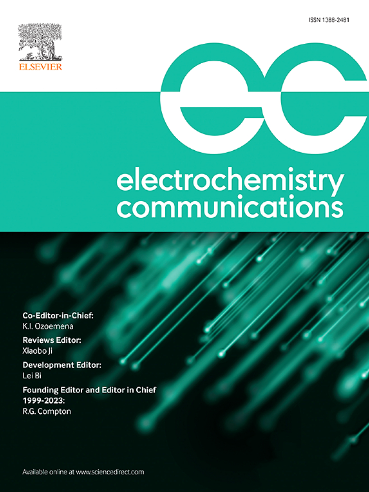NiFe共掺杂TiO2作为一种高性能双功能光催化剂,用于增强高效锌-空气电池系统中的析氧和还原反应
IF 4.2
3区 工程技术
Q2 ELECTROCHEMISTRY
引用次数: 0
摘要
该研究强调了Ni和Fe过渡金属掺杂以及NiFe共掺杂对增强TiO2性能的重要影响,以解决开发高性能光辅助锌空气电池的关键挑战,特别是对改善光吸收,电荷载流子分离和催化效率的需求。掺杂过程显著增强了光吸收和载流子分离,而TiO2晶粒尺寸的减小增加了表面面积,缩短了载流子扩散路径,从而使复合速率最小化,提高了光催化效率。此外,相对于TiO2的导带,Ni和Fe的氧化态具有较高的氧化还原电位,这使得它们能够作为高效的电子受体,稳定电荷载体,加速还原反应。电化学分析表明,与单元素掺杂的TiO2相比,nife掺杂的TiO2具有更好的电导率和更低的电荷转移电阻,有利于更快的反应动力学。对于OER,过电位从307 mV降低到221 mV,而对于ORR,光照使半波电位提高到0.65 V,扩散平台电流密度从3.96 mA/cm2增加到4.6 mA/cm2。电池性能测试表明,在光照条件下,充电电位降低到1.63-1.66 V,放电电压稳定在1.56-1.60 V,往返效率为96.34%,而在黑暗条件下,往返效率为77.59%。这些性能指标接近1.64 V的理论氧化还原电位,优于光辅助锌-空气系统中最先进的催化剂的能力。总体而言,本研究确立了nife掺杂TiO2作为高效双功能光催化剂的地位,突出了其优化析氧反应(OER)和氧还原反应(ORR)过程的潜力,从而促进了可持续储能技术的发展。本文章由计算机程序翻译,如有差异,请以英文原文为准。

NiFe co-doped TiO2 as a high-performance bifunctional photocatalyst for enhanced oxygen evolution and reduction reactions in efficient zinc-air battery systems
This study underscores the significant influence of Ni and Fe transition metal doping, as well as NiFe co-doping, on enhancing the properties of TiO2 to address the critical challenges in developing high-performance photo-assisted Zn-air batteries, particularly the need for improved light absorption, charge carrier separation, and catalytic efficiency. The doping process notably enhances light absorption and charge carrier separation, while the reduction in TiO2 crystallite size increases the surface area and shortens charge carrier diffusion paths, thereby minimizing recombination rates and improving photocatalytic efficiency. Moreover, the higher redox potentials of Ni and Fe oxidation states relative to TiO2's conduction band enable them to function as efficient electron acceptors, stabilizing charge carriers and accelerating reduction reactions. Electrochemical analysis reveals that NiFe-doped TiO2 exhibits superior conductivity and reduced charge transfer resistance compared to its single-element-doped counterparts, facilitating faster reaction kinetics. For OER, the overpotential decreases from 307 mV to 221 mV, while for ORR, illumination improves the half-wave potential to 0.65 V and increases the diffusion-plateau current density from 3.96 mA/cm2 to 4.6 mA/cm2. Battery performance testing demonstrates that under light irradiation, the charging potential is reduced to 1.63–1.66 V, and the discharge voltage is stabilized at 1.56–1.60 V, resulting in a round-trip efficiency of 96.34 %, compared to 77.59 % under dark conditions. These performance metrics approach the theoretical redox potential of 1.64 V, outperforming the capabilities of the state-of-the-art catalysts for photo-assisted Zn-air systems. Overall, this work establishes NiFe-doped TiO2 as a highly effective bifunctional photocatalyst, highlighting its potential to optimize oxygen evolution reaction (OER) and oxygen reduction reaction (ORR) processes, thereby contributing to advancements in sustainable energy storage technologies.
求助全文
通过发布文献求助,成功后即可免费获取论文全文。
去求助
来源期刊

Electrochemistry Communications
工程技术-电化学
CiteScore
8.50
自引率
3.70%
发文量
160
审稿时长
1.2 months
期刊介绍:
Electrochemistry Communications is an open access journal providing fast dissemination of short communications, full communications and mini reviews covering the whole field of electrochemistry which merit urgent publication. Short communications are limited to a maximum of 20,000 characters (including spaces) while full communications and mini reviews are limited to 25,000 characters (including spaces). Supplementary information is permitted for full communications and mini reviews but not for short communications. We aim to be the fastest journal in electrochemistry for these types of papers.
 求助内容:
求助内容: 应助结果提醒方式:
应助结果提醒方式:


